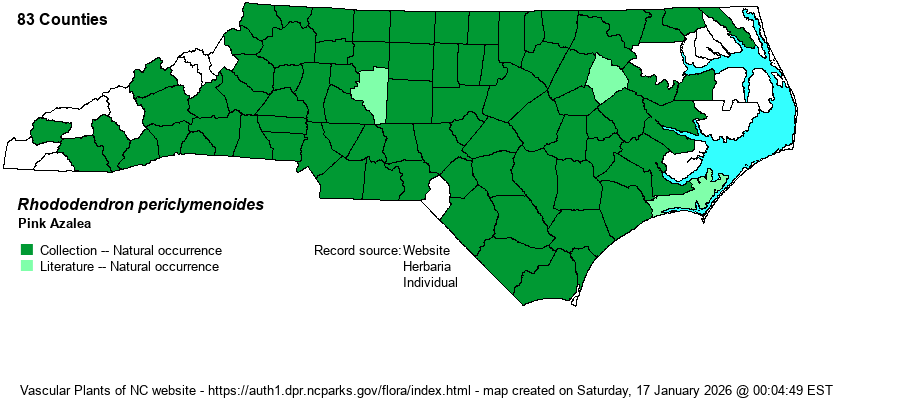| Author | (Michaux) Shinners | |
| Distribution | Occurs over nearly all of the state east of the Mountains, but clearly absent in the easternmost portion of the Coastal Plain, such as most of the Pamlimarle Peninsula and counties north of Albemarle Sound. It also is surprisingly scarce or absent in many Mountain counties, at least those without low elevations. A lack of records from low elevation counties in the southwestern corner (Cherokee and Clay) is puzzling, considering it occurs in many nearby counties in TN and GA.
The species has a wide range, occurring from New England (except ME) and NY south to southern GA, most of AL, and northeastern MS. It is absent from the Great Lakes states west of OH.
| |
| Abundance | Common and quite widespread across the Piedmont and most of the Coastal Plain; infrequent to fairly common in the central or southern Coastal Plain and low Mountains. Surprisingly scarce in most of the Mountains, as suitable habitat appears common. | |
| Habitat | It is widespread in mesic hardwood or mixed forests, usually on slopes and often along forested streambanks. It may occur on fairly dry forested sites, such as steep slopes and bluffs. It is scarce in bottomlands and wet habitats. |
| Phenology | Blooms from late March into May, before the leaves emerge; fruits in September and October. | |
| Identification | This is a familiar medium-sized, deciduous shrub, growing to about 6-10 feet tall. It has typical azalea leaves – thin, medium green (but not shiny) leaves that are elliptical to obovate and mostly clustered at the tips of twigs. It can often be identified by its clustered leaves at branch tips, but it is easily identified by its large tubular pink flowers, with flared petals, that are present before the leaves emerge. These flowers can be seen at long distances inside a hardwood forest in late March or early April, as most leaves of deciduous plants are not fully emerged to block the view of the observer. In those few counties in the southern Coastal Plain where R. canescens also occurs, you must take care to separate the two, though the latter occurs mainly in wetland sites. | |
| Taxonomic Comments | This species was, until recently, well known as R. nudiflorum. Maybe the name was changed to be less “politically sensitive”!
| |
| Other Common Name(s) | This species has no common name that is universally adopted. Pinxter-flower is often used, as is Wild Azalea, which is quite generic, as there are lots of native azaleas. Others include Pinxterbloom Azalea and Election Pink. | |
| State Rank | S5 | |
| Global Rank | G5 | |
| State Status | | |
| US Status | | |
| USACE-agcp | FAC link |
| USACE-emp | FAC link |

